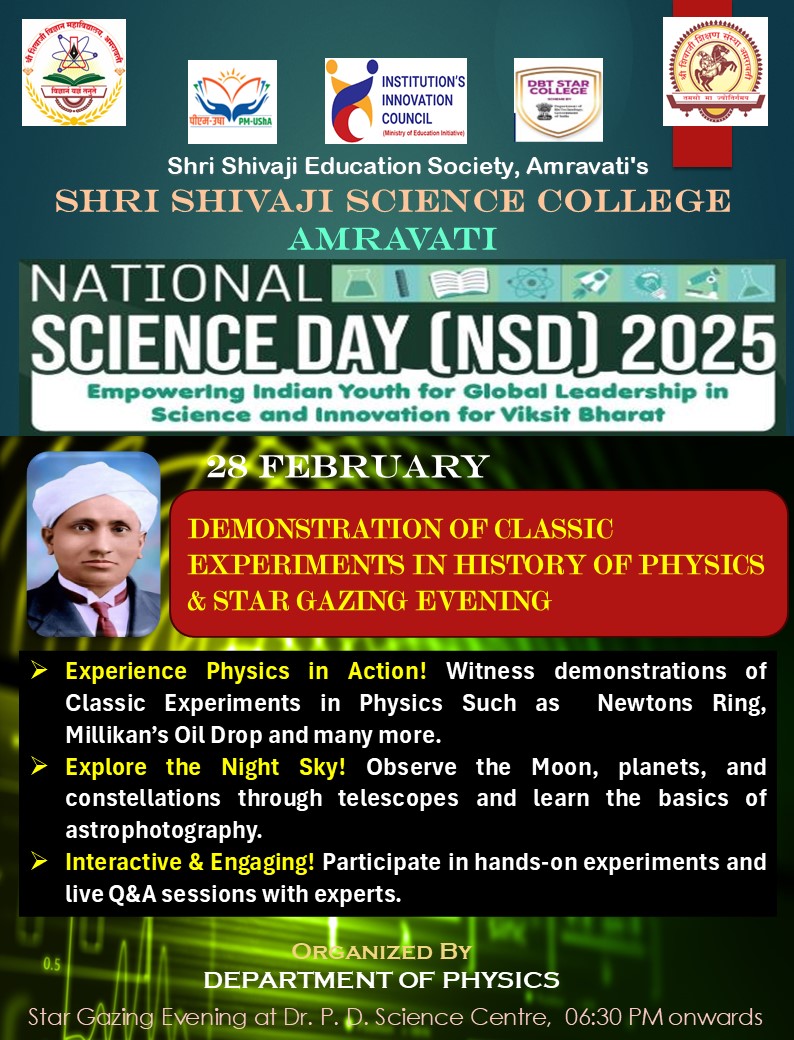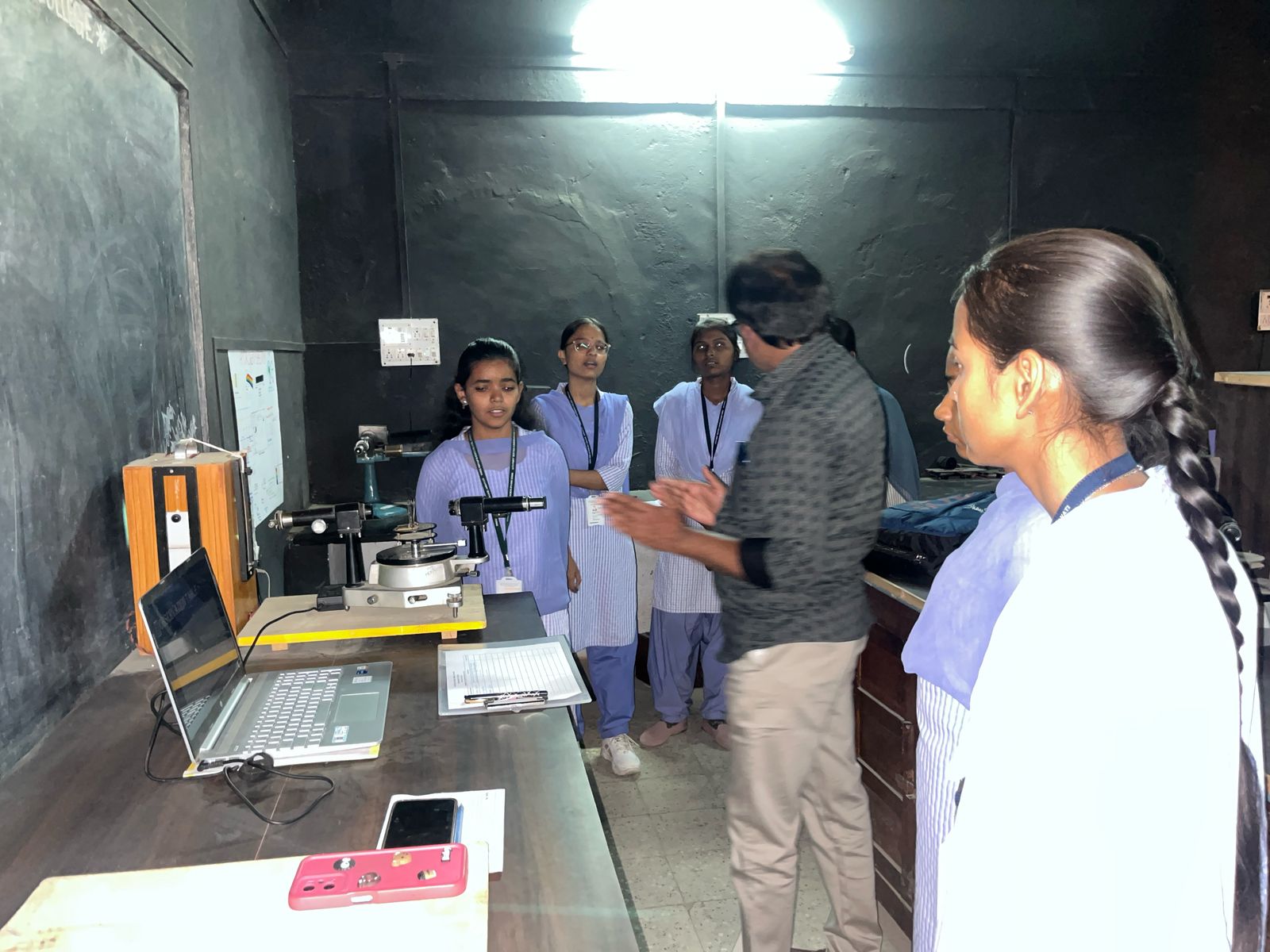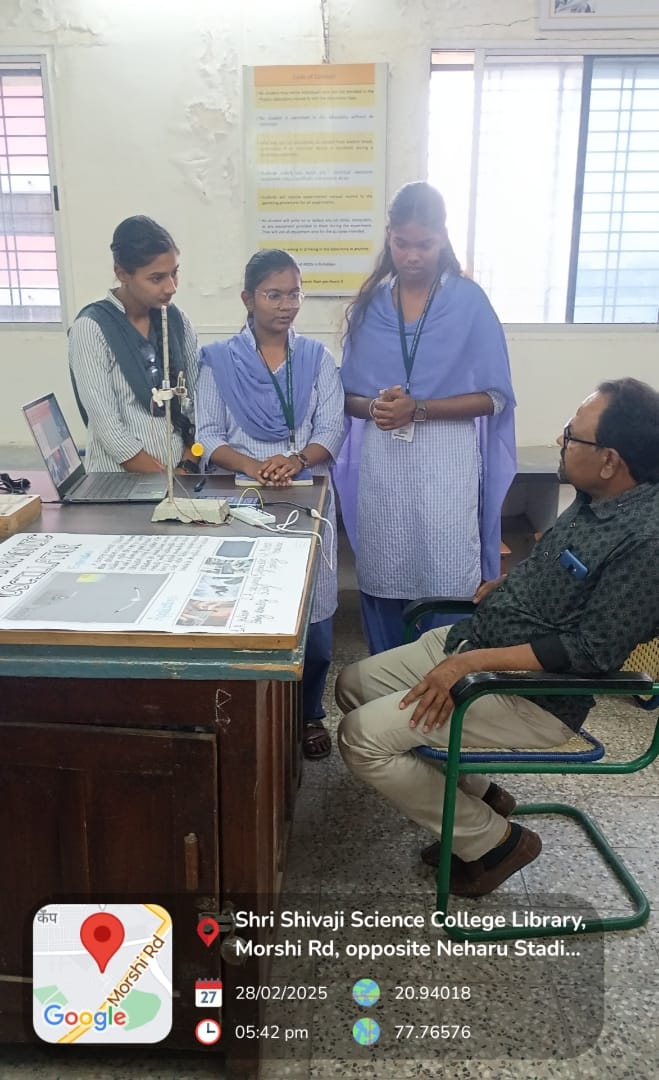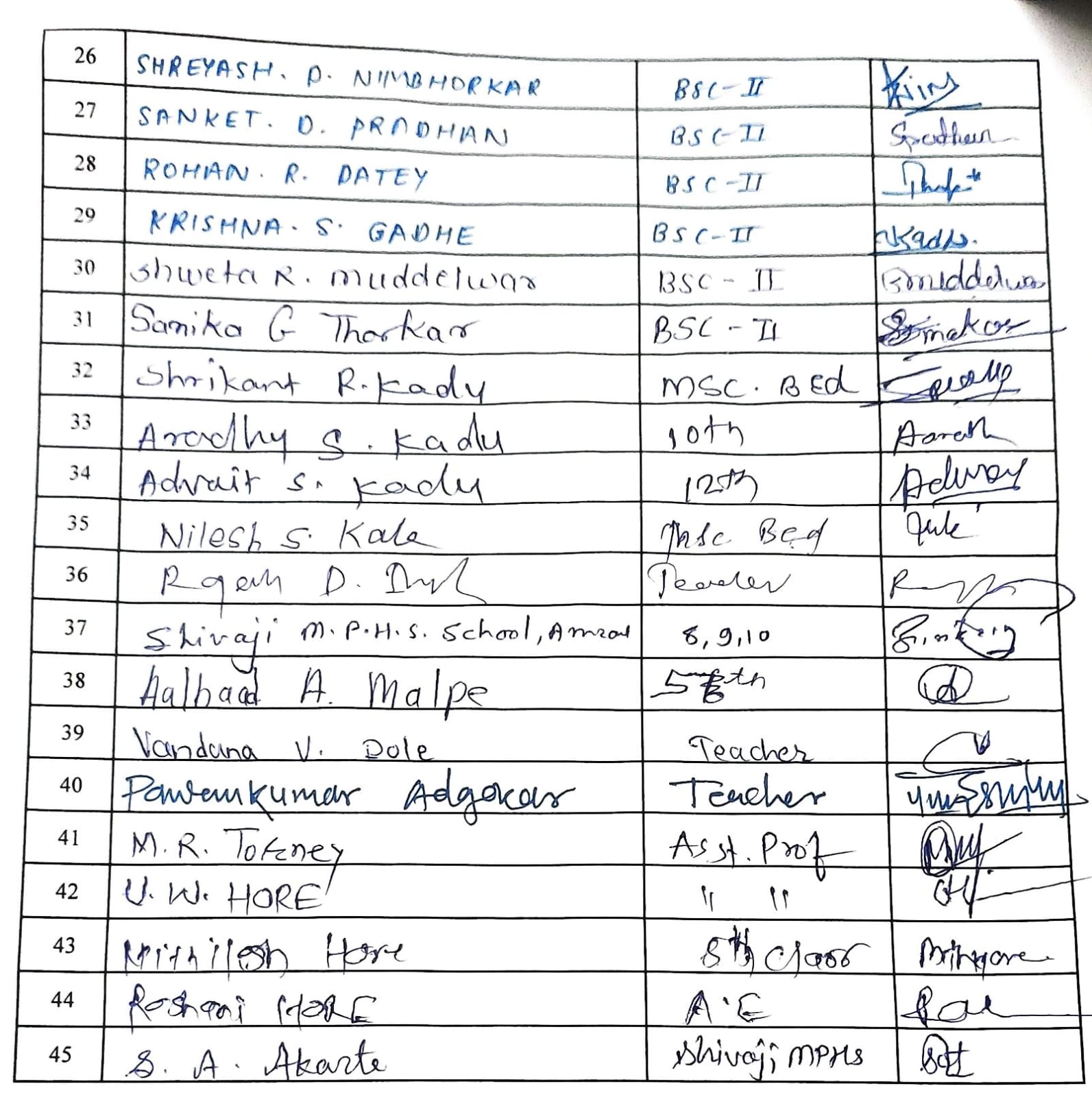SHRI SHIVAJI SCIENCE COLLEGE, AMRAVATI
DBT STAR COLLEGE PROJECT ACTIVITY
ACTIVITY REPORT

Celebration of National Science Day 2025 : Demonstration of Classic Experiments in the History of Physics and Stargazing Evening
Activity Dates: 28 February 2025
Type of Activity: Outreach Activity
Organizing Department: Department of Physics
Program Coordinators: Ms. S.M. Butte, Mr. S.S. Korde and Mr. S.M. Chinche
Head of the Department: Dr. P.A. Nagpure
External Collaborator (if any): No
Objectives:
- To commemorate the contributions of scientists and promote scientific awareness among students.
- To provide hands-on experience in conducting and understanding classic physics experiments.
- To develop interest in astronomy through stargazing activities.
- To encourage scientific curiosity and inspire students to pursue careers in science.
- To celebrate NSD 2025
No of Beneficieries: 115
Classes Involved: B.Sc. I, II & III and School Students, Teachers and Parents
Venue of the Activity: Dr. Panjabrao alias Bhausaheb Deshmukh Memorial Science and Innovation Activity Centre, Amravati
Activity Report:
The National Science Day was celebrated with great enthusiasm and interest in the Department of Physics at Shri Shivaji Science College, Amravati, on 28th February 2025. The primary aim of celebrating this day was to inspire students to engage in scientific experimentation, ignite their curiosity in science, and make them aware of the profound impact of science and technology in daily life. This year’s theme, “Empowering Indian Youth for Global Leadership in Science & Innovation for VIKSIT BHARAT,” served as a guiding principle for all the activities.
The celebration commenced with dignitaries Dr. G.V. Korpe, Dr. W.S. Barde, Dr. P.A. Nagpure, and Dr. S.S. Arsad offering floral tributes to the portrait of Sir C.V. Raman. The event was divided into two major segments: Demonstration of Classic Experiments in the History of Physics and a Stargazing Evening.
Segment 1: Landmark Experiments Demonstration
The first segment of the program was dedicated to the demonstration of landmark experiments that have played a pivotal role in shaping the field of physics. This segment was thoughtfully designed to bridge theoretical concepts with hands-on experimentation, allowing students to engage deeply with the fundamental principles that underpin the discipline.
Students from B.Sc. I, II, and III (Physics) and M.Sc. I and II participated enthusiastically, showcasing their skills, creativity, and understanding of experimental physics. A total of 26 students contributed to this segment, either by conducting demonstrations or by assisting with the setup and explanation. Each demonstration was meticulously prepared, ensuring both clarity and scientific rigor.
Experiments Demonstrated:
Newton’s Rings Experiment
Using a plano-convex lens placed on a flat glass plate and illuminated by monochromatic light, students demonstrated the formation of concentric circular interference fringes. The experiment highlighted the wave nature of light and provided an elegant way to measure the wavelength of light and study the principles of constructive and destructive interference.
Young’s Double Slit Experiment
This iconic experiment beautifully illustrated the wave nature of light by producing an interference pattern with alternating bright and dark fringes. Students meticulously aligned the slits and adjusted the laser source to obtain clear fringes, explaining the underlying principles of superposition and coherence.
Young’s Single Slit Experiment
To emphasize the concept of diffraction, a single slit was illuminated with monochromatic light, resulting in a central bright fringe surrounded by diminishing side fringes. The demonstration allowed students to discuss the relationship between slit width, wavelength, and fringe width, deepening their understanding of wave optics.
Hydrogen Spectrum Experiment
Students used a discharge tube filled with hydrogen gas and a spectrometer to observe and measure the characteristic spectral lines of hydrogen. They explained the Balmer series and its significance in validating the Bohr model of the atom, emphasizing the quantization of energy levels.
Mercury Spectrum Experiment
Using a mercury vapor lamp and a spectrometer, students studied the discrete emission lines of mercury. They discussed the role of these lines in the development of quantum mechanics and their applications in devices like mercury vapor lamps and calibration standards.
Diffraction Grating Using Laser Experiment
This demonstration showcased the diffraction of laser light through a high-quality diffraction grating, producing a sharp and well-resolved pattern of bright spots. Students explained how diffraction gratings are used in spectroscopy and how they enable precise wavelength measurements.
Thomson’s e/m Ratio Experiment
Using a cathode ray tube, Helmholtz coils, and a voltmeter-ammeter arrangement, students demonstrated the measurement of the charge-to-mass ratio (e/m) of electrons. They explained how the deflection of electron beams in a magnetic field provided one of the first insights into the properties of subatomic particles.
Millikan’s Oil Drop Method
This classic experiment was set up to determine the fundamental charge of an electron by balancing the gravitational force and the electric force on tiny oil droplets. Students discussed the significance of this experiment in quantifying the elementary charge and validating the atomic nature of electric charge.
Damped Harmonic Oscillator Experiment
Using a spring-mass system with a damping mechanism, students analyzed the effect of damping on oscillations. They plotted displacement-time graphs and determined the logarithmic decrement, explaining the importance of this concept in real-world systems.
Free Fall Experiment
A simple yet powerful demonstration, this experiment involved measuring the time taken by a ball to fall a known distance using a stopwatch. Students calculated the acceleration due to gravity (g) and discussed sources of error and improvements using modern sensors and technology.
The jury for this segment was chaired by Dr. W.S. Barde, former Head of the Department of Physics at Shri Shivaji Science College, Amravati. Dr. Barde and the other members of the jury were highly impressed with the precision, confidence, and depth of understanding displayed by the student presenters. They praised the students for their clarity of explanation and their ability to connect theoretical knowledge with practical demonstration.
This segment not only enriched the students’ learning experience but also inspired them to appreciate the legacy of experimental physics and its continuing relevance in modern science and technology.
Prizes:
• First Prize: Sakshi V. Pathare, Gayatri P. Sardar, Nikita R. Rajgire (Hydrogen Spectrum Experiment)
• Second Prize: Vedika M. Dongare, Vedika M. Waghmare, Aarti S. Gawande (Time of Flight Experiment)
• Consolation Prizes: Two teams were awarded for their excellent efforts.
Segment 2: Stargazing Evening
Venue: Dr. Panjabrao alias Bhausaheb Deshmukh Memorial Science and Innovation Activity Centre, Amravati
The second segment was a Stargazing Evening open to all students, teachers, and local community members. Telescopes and binoculars were arranged by Mr. S.S. Korde and Mr. Suraj Chinche. Participants had the opportunity to observe celestial bodies such as Venus (noting its different phases) and Jupiter with its four moons (Io, Europa, Ganymede, and Callisto).
• Io: Known for its volcanic activity and sulfur-covered surface.
• Europa: Notable for its icy crust and potential subsurface ocean.
• Ganymede: The largest moon in the solar system.
• Callisto: Known for its heavily cratered surface.
Dr. P.A. Nagpure conducted an informative session on star observation and constellation identification, captivating the audience with the wonders of the night sky. Parents and students from local schools also attended, totalling around 115 participants.
Recommendations by the students
1. Organize more science-themed events and competitions to promote hands-on learning and innovation.
2. Invite guest scientists from prestigious research institutions to deliver lectures and share their experiences.
3. Establish an Astronomy Club to sustain student interest in space science and stargazing activities.
Acknowledgments
We extend our sincere gratitude to the college administration, faculty members, judges, and student volunteers whose dedication and support made this event a resounding success. Special thanks to Mr. S.S. Korde and Mr. Suraj Chinche for arranging the telescopes and equipment, and to all the participants for their enthusiastic involvement.
Outcomes:
- Enhanced student understanding of key physics experiments and their historical significance.
- Cultivated interest in scientific inquiry and experimentation.
- Inspired students to explore careers and research in physics and astronomy.
- Fostered collaboration and teamwork among students during the demonstration.
- Provided an opportunity for community engagement through the stargazing activity.
Photos:
 Dr. P.A. Nagpure conducting an informative session on star observation and constellation identification |  The students awarded with a certificate of participation in NSD 25 activities |
 Students demonstrating classic experiments in physics |  Students demonstrating classic experiments in physics |
 Students demonstrating classic experiments in physics |  Students demonstrating classic experiments in physics |
Attendance Sheet:
 Sheet |
 Sheet |
 Sheet |
 Sheet |
 Sheet |
 Sheet |
 Sheet |
 Sheet |